Gulls don’t come near him. This spring, he had the ratcheting call of magpies, who made a nest on his crane. He stepped over it every day to reach his cab. Two chicks hatched from the clutch of five eggs. Then one day they had all disappeared. He doesn’t know if they made it.
Brian is one of more than 100 men – and they are all men – who work in the clouds above Dublin, registered with the union Unite. They operate dozens of tower cranes on the city skyline, one or two to a cab. They are called Rope Jockeys or Eyes in the Sky by building site colleagues. They have other nicknames too, but Brian says these are unprintable.
He knows crane operators who leave homes in the midlands or Mayo at 5am on workdays. Many of them are building a city in which they cannot afford to live. The last leg of their journey is the climb from ground to cab. It takes anywhere from five to 20 minutes, depending on the height of the crane. They are at their controls by 7am and may stay there for up to 12 hours or more, sometimes taking their breaks in the cab, lifting and lowering concrete, timber, glass and steel as the city’s office buildings, hotels and student housing blocks rise up from the ground to meet them.
Depending on the height of their crane, some of the men will climb down for a break during a shift, but if the pressure is on the crane operator will stay in his cab and take his break there. Unite’s Rob Kelly, regional organiser with the union representing crane operators, says legislation on working hours is routinely ignored.
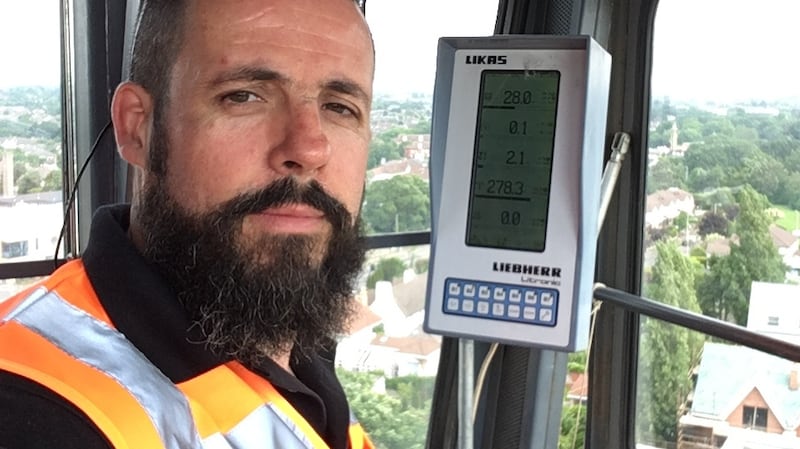
If a concrete delivery arrives at the end of a shift, Kelly says, they’ll work till it’s poured. When the operators climb down with stiff shoulders and cricked necks back to life on the ground, their cranes hang like huge steel beasts with blinking aviation lights over homes and streets. We move, work, sleep and shop under them, trusting and oblivious. It’s not something Brian overthinks, but many lives on the ground are in the hands of a Dublin rope jockey.
Unofficially blacklisted
Brian is not his real name, but he says it's easy to get unofficially blacklisted by the agencies who employ crane operators. "The majority are working through agencies," Kelly says. Work can be on a week-to-week basis with a text message to tell the operator at the end of the week whether he's needed the following week. Brian has been a crane operator on and off for 20 years. After the last economic crash, he left for Europe, and then Australia.
The only voice in his cab connecting him to the ground is his banksman, who talks to him through the walkie-talkie. Then there’s the odd podcast or audio book (he likes non-fiction). Every crane operator works with a banksman (or several banksmen) who connects the rigging to the loads, and tells him when it’s clear to lift and lower. Brian has worked with the same banksman for years. These kinds of partnerships are not as common as they were during the last boom, he says.
Sometimes I wonder, what kind of a city are we building? I come in early and already there are lads sitting in their cars eating their breakfasts at the wheel
Everything in this boom is more focused, bigger and engineered to keep the money flowing upwards to the big construction companies, and the international funds behind them. Crane operators keep their mouths shut and do what they’re told, Brian says. The worst days happen when you’re teamed with a banksman who’ll send panic up the crane, scream into the radio until your head is fried. A calm approach is everything.
And a head for heights? “You work yourself up into the crane. If I rush up the crane, sometimes I’ll get to the top and it’ll feel like too much,” he says. “You take your time going up and you adjust as you go. If you have a bad banksman, the first thing you do is take him up the crane. The height will scare him and he’ll see how difficult cranes are to operate.”
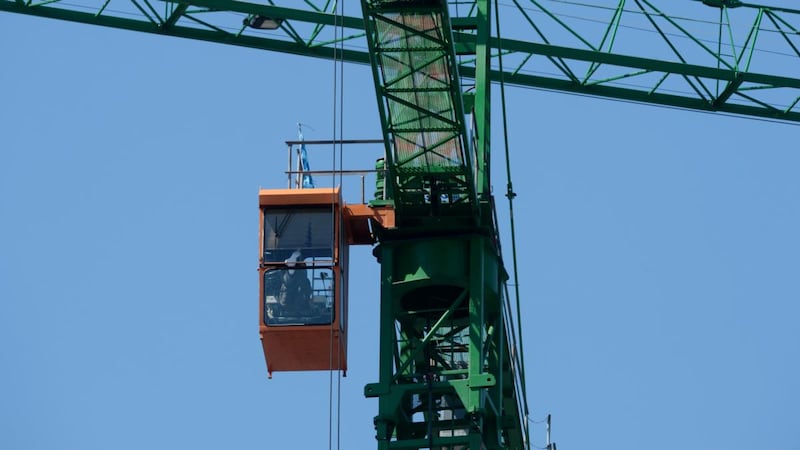
What does he make of this boom from his seat in the sky? “Sometimes I wonder, what kind of a city are we building?” he says. “I come in early and already there are lads sitting in their cars eating their breakfasts at the wheel.” He has a unique 360º view of the ant colony below. “You can actually see the rhythm of a city,” he says. He can spot the same cars coming and going at certain times of the day. Sometimes he wishes they’d write something on their roofs, just to liven up the view.
‘Bottle of home brew’
And yes, he urinates in a bottle. There is no Dublin tower crane with a toilet, according to Unite’s Rob Kelly. Everyone brings down a “bottle of home brew and maybe worse, depending on the height of the crane”, Brian says, miming tucking a bottle into his jacket to free up his hands for the long climb down. Because, of course, you can’t carry your bottle down the crane. You need both hands free for the ladder.
Very few cranes have air conditioning, so on a sunny day it’s like sitting in a stationary car for hours. Lots of cranes have plenty of space on the back jib (the horizontal beam of the crane) for toilets, even a kitchen, he says. “I’ve got 15 metres of space on the back of my crane. It’s quite big. You’d nearly live in it.” But the comfort of workers is not a priority. Having the crane operator at his controls at almost all times is what’s required.
When it's windy, the best way I can describe it is that it feels like sitting on a boat
There can be 30 lifts on a quiet day, and on some days 30 lifts before your first break.
He is keeping a note of all the issues with the crane he is using at the moment, in a small black notebook with the crane’s serial number written on the front. He flips through the pages filled with dates and notes. These are the incidents, the times that something has gone wrong. “I’ve got to keep this for when an accident happens,” he says. There is an official form to be filled in weekly for faults like power problems or radio outages, but it’s a process that comes with its own hassles. Crane owners who don’t want to spend the money fixing the faults “will go mental and attack the integrity of the driver”, Brian says.
He’s worked in many kinds of weather. “When it’s windy, the best way I can describe it is that it feels like sitting on a boat.” It takes all his skill to try to control a load on the end of the rigging when the wind gets up. Get a thin, long and wide load, and it will get whipped around “just like a kite in the sky”, he says. Small solid loads are easier. Then there are the radio failures, where your eyes on the ground are lost. That’s when all your training and reserves of calm come into play.

Dublin is tower crane city. Every month, this newspaper's unofficial crane correspondent Justin Comiskey goes onto the roof of The Irish Times building on Tara Street and counts the cranes. In March, Dublin reached peak crane when Comiskey logged a record high of 123 cranes. In the US, Seattle holds the record for the largest number of cranes in an American city, thanks to a wave of office and apartment building for tech companies. But the US crane capital's crane count earlier this year was just 60, half the number in operation in Dublin.
In April, one of Seattle’s cranes collapsed in a storm, killing four people on the ground. Brian has watched the footage repeatedly, trying to work out what happened.
Dublin's biggest tower crane accident happened 15 years ago in February 2004, when a 60-metre crane snapped near the Dart track in Ringsend in a storm. No one was injured, but Irish Rail lost more than €150,000 in ticket revenue, and dozens of homes in Emerald Cottages and Barrow Street had to be evacuated as the stricken crane swung in the wind over the houses before it could be safely dismantled.
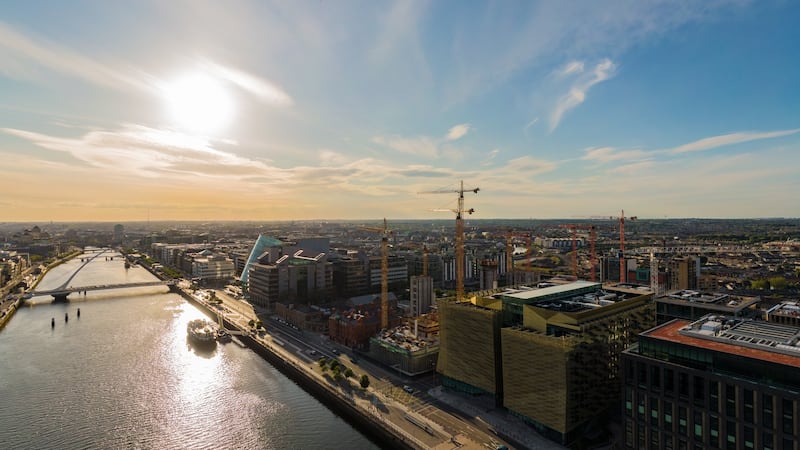
In Australia, the norm was to take photographs of everything in the event of an accident, and circulate it to all the other construction sites to alert them to potential hazards, Brian says. He learned more in his time there about what can go wrong than he ever did at home. It was one of the few places he encountered a woman at the controls. “She was the best crane operator I knew. If you looked at her during the day, her crane looked really slow, but she’d always have moved more than anyone else by the end.”
Incidents happen
Incidents happen in Dublin, but we don’t tend to hear about them. Recently, a friend of this reporter was walking down a street in the city centre when she felt a sudden whoosh of wind at her back, strong enough to lift her skirt. Before she could turn to see what was happening, there was “an almighty bang”. A load of timber planks had dropped out of the sky onto the footpath where she had been just seconds earlier. She looked up and saw that a small crane had discharged its load. There was nobody else around to marvel at her lucky escape. She took a breath and walked on, slightly dazed, reached for her phone to ring her husband to tell him what had just happened. She did not report the incident, and doesn’t know if anyone else filed a report.
Accidents are reported to the Health and Safety Authority in the case of a fatality, or if someone is injured and out of work for more than three days. “They try and get you back to work within three days if you can walk so they don’t have to report the accident,” Brian says.
Every crane will have a method statement specifying how it should be used, the size of the lifts and the weather conditions in which it can be used. Chains and lifting harnesses are subject to regular inspections, according to James O'Connor, senior lecturer in Technical University Dublin's School of Surveying and Construction Management. Wind is the biggest hazard. At certain wind speeds, cranes are "winded off". Sites in Sandyford in south Dublin are notoriously tricky for tower cranes as the wind comes over the mountains. In the Docklands, the wind can barrel down the river.
The crane operator is the first man on the site and the last to leave
It is standard practice in high winds or storms to leave a crane in “freeslew” so that the jib can be blown where the wind takes it. Tower cranes become gigantic weather vanes, showing the city the direction the wind is blowing when they are left empty and in freeslew mode in strong winds.
O’Connor says cranes feature so heavily in Dublin because of the scale of the building and the tightness of the sites. In some sites, the crane will be built into what will become the lift shaft of the building. Large numbers of cranes on the skyline is an indication of a lot of building starts, O’Connor says.
“The crane operator is the first man on the site and the last to leave,” O’Connor says. “You’re the key operator on the site.” Does he see a day when cranes will be robotically controlled and the days of men sitting in cabs in the sky will be over? “I couldn’t see the likes of that,” he says. Although smaller cranes are now routinely operated from the ground.
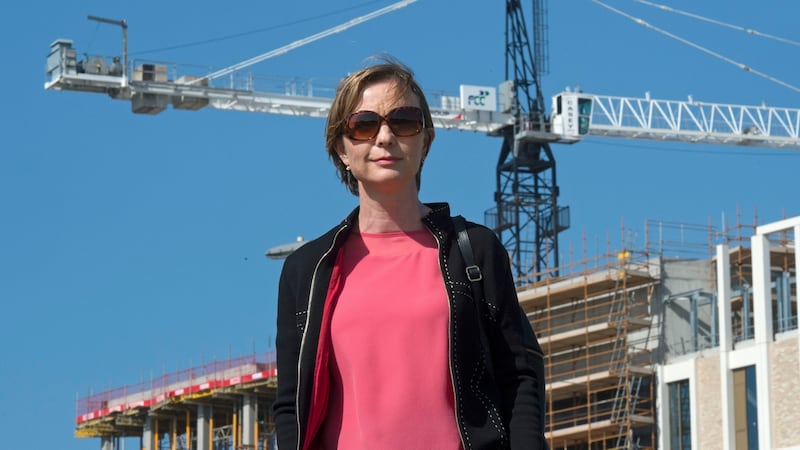
Architect Collette Burns compares the widespread use of tower cranes to the “as you need it” logistics supermarkets use to minimise their storage on site. Before her recent appointment as architectural project leader at the Technical University’s Grangegorman site, she worked for two years on the former Central Bank building redevelopment. “Two huge cranes did everything. They were non-stop,” she says. “They are very heavily programmed . . . Everyone had a slot” for their timed delivery of materials or sections of pre-fabricated parts onto the site. “So when the cranes are down, chaos ensues.”
Windy day
As we talk, it’s a windy day on the Grangegorman site, so the cranes are being affected. She says she is not an expert on the management of construction sites, but she can imagine how “very very stressful” it is to be a crane operator when the schedule of lifts starts to back up. “If you’re delayed on one thing, then you’re under pressure to speed up.”
I don't know of any general operatives in any other sector operating machines worth over €1 million for €18.36 an hour
The final dismantling of a crane on a job you’ve been involved in is a big day for an architect, Burns says. “Everyone’s delighted when they come down. It means you’ve reached a certain point on your project and the rest of the jobs are more under your own control.” These are the human scale jobs done manually by site workers, electricians and fitters.
Crane operators went on strike for better pay in the summer of 2017. Unite was seeking a series of pay increases to take operators’ pay to €30 an hour by this year. Kelly says the pay rate is still at €18.36 an hour, and crane operators are still classified as general operatives. The threat of a further dispute has not gone away. Kelly is worried at the relentless pressure crane men are under to stay in their cabs, and work back-breaking hours.
“I don’t know of any general operatives in any other sector operating machines worth over €1 million for €18.36 an hour, moving tonnes of weight above hundreds of workers and over public streets . . . They urinate in bottles and if someone needs to do a number two and they’re pouring concrete they’ll be told to stick a cork in it.”
If construction companies want to operate cranes 12 or more hours a day, Kelly says they should employ relief drivers, two operatives per crane. “They know this boom is not going to last so they’re working 70-hour weeks. If you believe in family life and community, imagine the negative impact that’s having,” Kelly says. “The most frightening thing for me is the lack of training for these guys and the banksmen.”
The pressure from the “vulture funds” behind Dublin’s biggest building sites is “phenomenal”, Kelly says. One union member was employed for four years as a crane operator on a city centre building site, putting his life on hold to work the hours it took to get the job finished. When the man asked where his next job would be, he was told by the large construction firm that he was not an employee.
Cavalier attitudes to humans are routine across the sector. It bothers Brian that Dublin cranes don't have lift hoists that would allow another construction worker to get to his cab if he needed to be rescued. There are mobile hoists available on some sites but these are not standard, Kelly says. Lift hoists on tower cranes are standard in other countries. The rescue plans involve Dublin Fire Brigade sending someone to climb the ladder to get to an operator like Brian if he was ill or injured. "I'd be waiting an hour," he says grimly.
Giving crane operators special status on sites would not only improve their pay and conditions, but could also improve safety for citizens walking, sleeping or working underneath the tonnes of steel and concrete.

Is Brian required to pass any blood or breath tests before he climbs skyward to take the controls on his crane, was one of my final questions? No, is the answer. If he was tested, then every worker on the site would also have to be tested.
He likes the job. Crane operators tend to have similar personalities. The good days are when the shift goes well, “the feeling of being part of a good team, getting through the day with no hassles”. Those days are what we on the ground wish for too, for everyone’s peace of mind.
What are our tower cranes building?
Like tower cranes in a storm, it feels that Dublin's construction is going where the wind blows it. The Government's Housing Agency has stated that more than 35,000 homes are needed in Ireland each year "to meet current demand". The construction industry in the capital has put housing much further down their list of priorities. The sector is going where the money blows it.
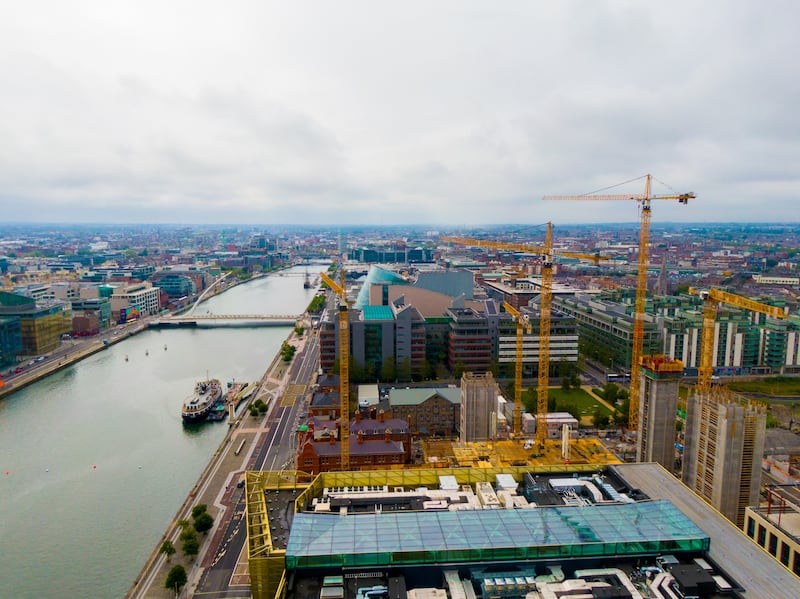
Last year in the Dublin City Council area, cranes were constructing 5.6 million square feet (520,257sq m) of office space, up from four million in 2017, a jump of 40 per cent. They were building 4,119 residential units. Hotel developments numbered 2,752 beds, and there were further 4,069 student accommodation beds under construction.
These figures were compiled in the Deloitte Real Estate Crane Survey, which looks at construction activity in Belfast, Birmingham, Leeds, Manchester and Dublin. More than 50 per cent of the new office space in Dublin's centre last year was taken up by tech companies, it noted. In Manchester (population 530,000), 14,480 residential spaces were under construction, a 30 per cent increase on 2017.
In Dublin, hotel and student housing developments outnumbered residential development by more than 2,700 units. We were building 6,821 hotel and student beds last year, compared to 4,119 residential units, less than a third of Manchester’s residential building total.

















